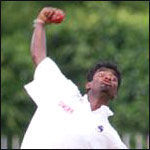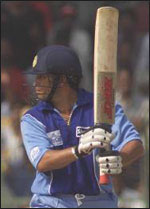Those wicket ways
Daniel Laidlaw
After the provisional retirement of Courtney Walsh last week, the natural
question arose of if, or when, his phenomenal career tally of 519 wickets
would ever be broken. Walsh, the granddaddy of contemporary fast bowlers,
set a new mark for all others to aspire to as the founding member of the 500
Test wicket club, calling it a day after another typical contribution to a
West Indies victory in his native Jamaica.
Walsh's nearest rival on the career wickets list is of course the retired
Kapil Dev, whose world record Walsh broke last year, with 434, followed by
active fast bowler Wasim Akram on 409. In that context, with such a margin
between he and the rest, one might expect Walsh's record to stand for some
time as a tribute to him. Except it won't.
Instead of serving as an unattainable landmark that no-one else can hope to
reach, Walsh's record should actually prove a pioneering figure that will be
emulated and exceeded many times by a new generation. It seems impressive
now and will always remain a historic achievement by a legend of the game,
but the figure itself is not one that will stand the test of time.
 Walsh played 132 matches, over 16 years, for his 519 wickets. That is an
average of approximately 33 wickets per year, at 3.9 per match. The ICC's
10-year plan is just about to commence, meaning more matches than ever
before, played by cricketers who are fitter than any previous generation and
who play well into their 30s. This makes it increasingly likely that
aggregate career records, such as highest number of runs and wickets, are
going to keep statisticians busy as they are re-written in the forthcoming
years.
Walsh played 132 matches, over 16 years, for his 519 wickets. That is an
average of approximately 33 wickets per year, at 3.9 per match. The ICC's
10-year plan is just about to commence, meaning more matches than ever
before, played by cricketers who are fitter than any previous generation and
who play well into their 30s. This makes it increasingly likely that
aggregate career records, such as highest number of runs and wickets, are
going to keep statisticians busy as they are re-written in the forthcoming
years.
Some suggest that even though his record may be broken, Walsh will remain
the only fast bowler to capture so many wickets. However, with improved
fitness levels and increased knowledge of injury prevention, it is doubtful
even that feat will remain unique. The fact Walsh was easily the leading
wicket taker from either side in his final series as a 38-year-old says more
about the man's quality than 500 wickets.
The question is, just how far will it go? 500 wickets is an unprecedented
achievement. But is it possible that mark could be doubled in future, as
Test cricket witnesses a 1000-wicket bowler?
 At this stage it seems remote, but in the future the answer is likely to be
yes. Certainly, some new feats are bound to be recorded. Sri Lanka's
spinning wonder, Muttiah Muralitharan, has snuck up relatively quietly to
317 wickets, in phenomenally quick time. At only 29, the freakish
off-spinner appears the first most likely candidate to surpass Walsh if he
remains free of major injury.
At this stage it seems remote, but in the future the answer is likely to be
yes. Certainly, some new feats are bound to be recorded. Sri Lanka's
spinning wonder, Muttiah Muralitharan, has snuck up relatively quietly to
317 wickets, in phenomenally quick time. At only 29, the freakish
off-spinner appears the first most likely candidate to surpass Walsh if he
remains free of major injury.
Last year, Sri Lanka played 10 Tests. In 62 career matches, Muralitharan has
claimed his 317 wickets at the extraordinary rate of more than five per
match. If we extrapolate on that, and assume he plays for another 6 years at
only 10 matches per year - a conservative figure - it is reasonable to
predict that 'Murali' will finish on around 600 wickets at the very least.
He's not the only one among the current generation who should pass 500.
Examining CricInfo's list of active bowlers with more than 200 wickets, it's
plain to see the Catch Courtney Campaign is already on in earnest. Murali
will be the first, in around four years, but surely not the last.
Glenn McGrath has 326 wickets from 70 matches, at 4.6 per match. If he plays
for another five years at 50 wickets per year, he too will have gone past
the magical 500 milestone. It's the same for 27-year-old Shaun Pollock. He
debuted less than six years ago and has accumulated 231 scalps in 56 matches
since then, at slightly more than four per match. Depending on how long he
plays, Pollock should also pass 500.
The list goes on. As more matches are played and super-cricketers continue
to develop, 500 may eventually become the significant milestone, rather than
the current 300. Courtney will always remain the inaugural member, but the
500 club is going to be a burgeoning one.
 It is a similar trend for batsmen. Of the modern batsmen, it is already
accepted that Sachin Tendulkar will shatter the records of Border and
Gavaskar, with Mark Waugh declaring recently that he would be surprised if
Tendulkar did not finish with 40 centuries. It doesn't take a crystal ball
to realise the record for highest number of runs and centuries will belong
to Tendulkar by the time he retires. But unlike Walsh, the records he
establishes may be a lot harder to surpass, as at 28 years old and already
with an imposing tally behind him, he is also young enough to be part of the
new generation to benefit from an increased Test schedule. 20,000 Test runs?
Probably not, but 15,000 is certainly realistic.
It is a similar trend for batsmen. Of the modern batsmen, it is already
accepted that Sachin Tendulkar will shatter the records of Border and
Gavaskar, with Mark Waugh declaring recently that he would be surprised if
Tendulkar did not finish with 40 centuries. It doesn't take a crystal ball
to realise the record for highest number of runs and centuries will belong
to Tendulkar by the time he retires. But unlike Walsh, the records he
establishes may be a lot harder to surpass, as at 28 years old and already
with an imposing tally behind him, he is also young enough to be part of the
new generation to benefit from an increased Test schedule. 20,000 Test runs?
Probably not, but 15,000 is certainly realistic.
Other than Tendulkar, no batsman is on the immediate record-breaking horizon
like the current list of fast bowlers, but the next wave of elite batsmen
can reasonably be expected to pass 10,000 career runs. At close to 1000 runs
per calendar year over ten years or more, which should not prove overly
difficult at upwards of 15 matches each year, it is easy to envision the
10,000 run club expanding further than Border, Gavaskar and, eventually,
Tendulkar.
What all this proves is that while landmarks and milestones of the
cumulative nature are outstanding achievements and testimony to longevity
and sustained quality, they do not necessarily indicate superiority over
cricketers of the past. In the ambiguous world of cricket stats, averages
remain better, if incomplete, indications of greatness.
Mail Daniel Laidlaw